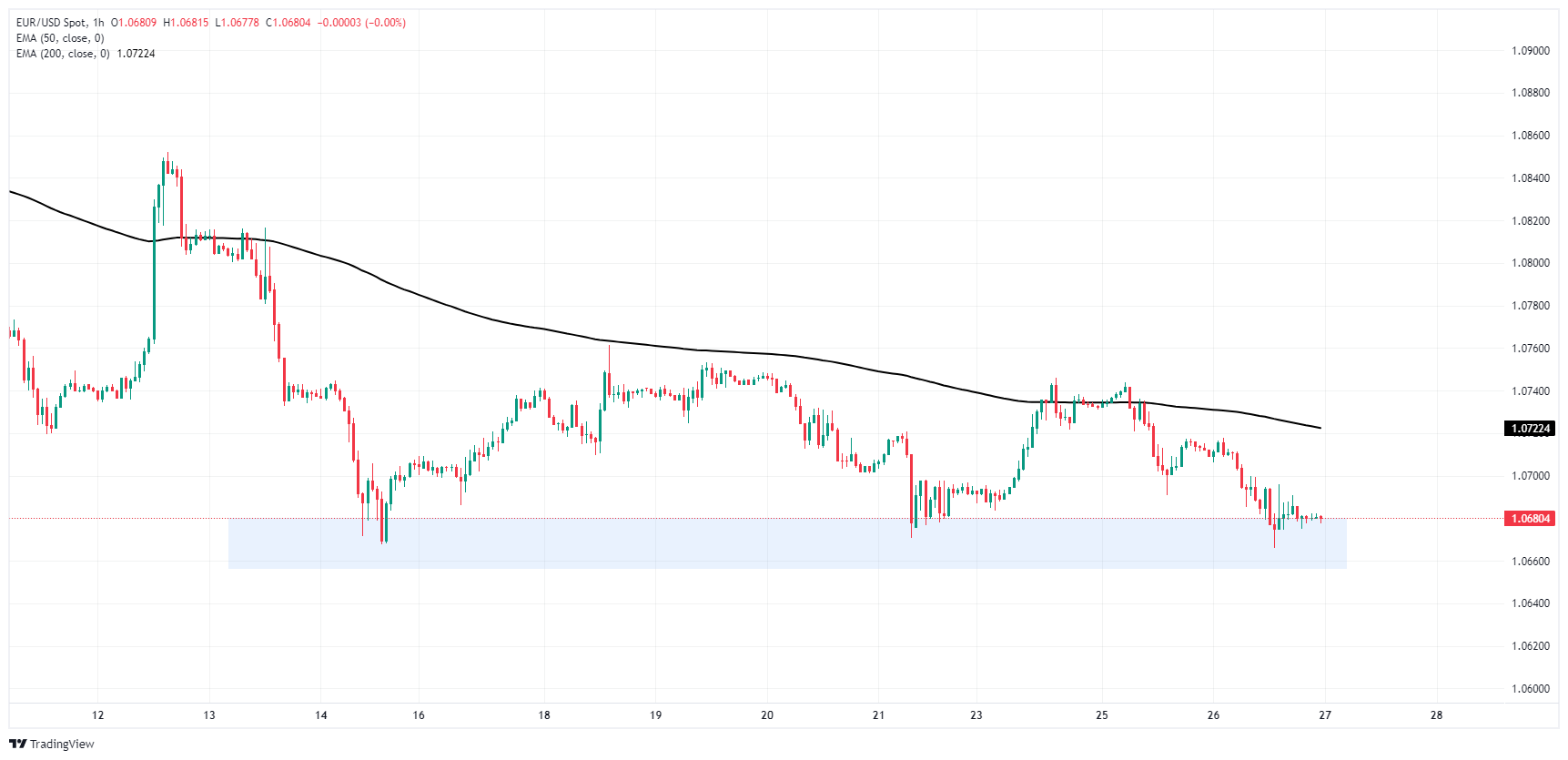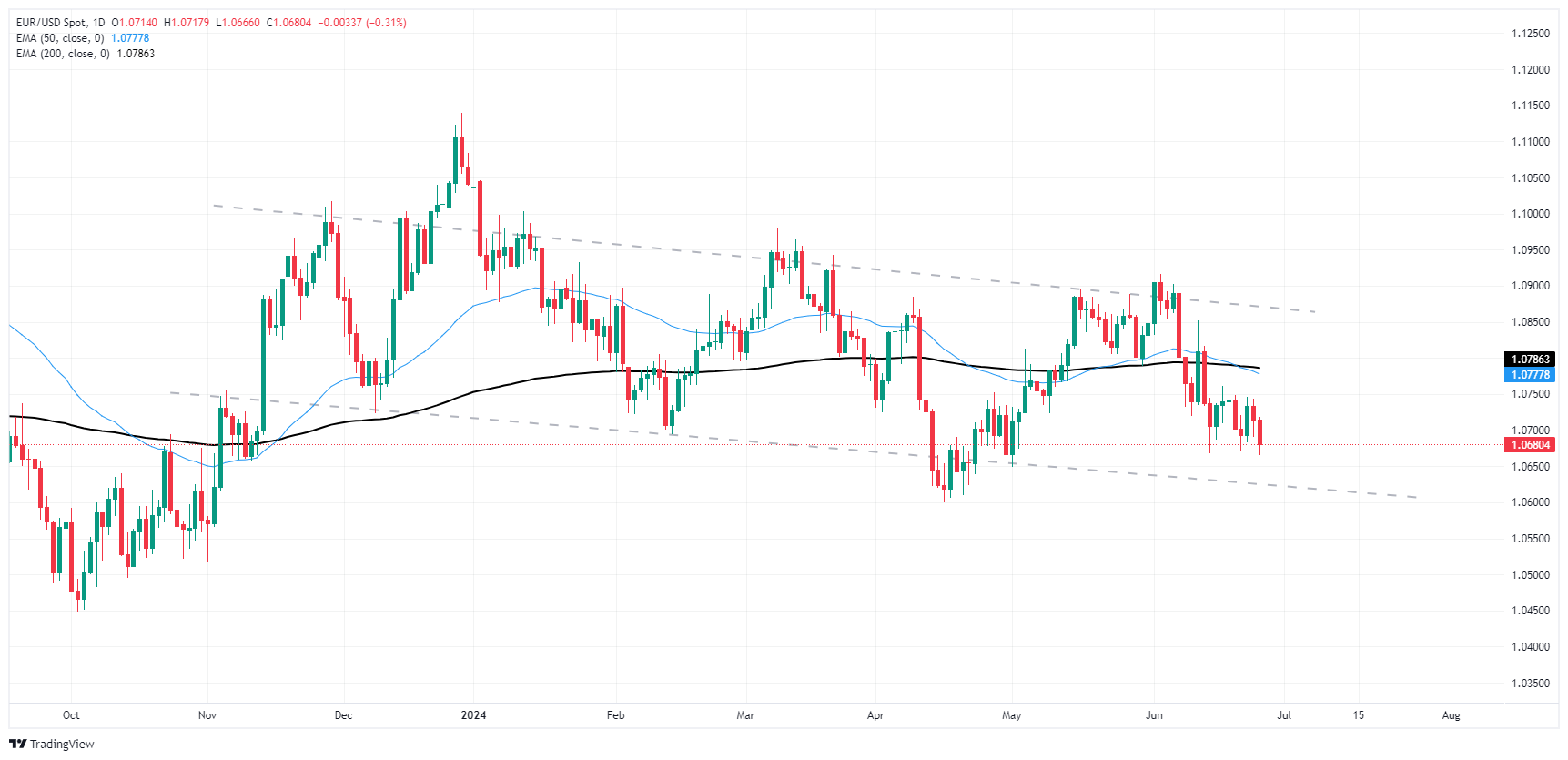- Analytics
- News and Tools
- Market News
- EUR/USD pinned into low end below 1.0700 once again
EUR/USD pinned into low end below 1.0700 once again
- EUR/USD flubs the 1.0700 handle as bearish flows keep the Fiber pinned.
- Broad-market sentiment favored the Greenback on Wednesday as rate cut hopes dry up.
- Late-week key data prints to drive market momentum after an easy start to the week.
EUR/USD backslid into the 1.0680 region on Wednesday after the German GfK Consumer Confidence Survey for July ticked lower unexpectedly, and a lack of meaningful data during the American trading session left investors to chew on a cautious Federal Reserve (Fed) stance this week that saw rate cut bets shift lower.
Forex Today: Investors look at US PCE and French elections
German consumer confidence backslid to -21.8 for July, missing the forecast recovery to -18.9 from the previous month’s revised -21.0. Despite a slow and steady recovery in the German GfK Consumer Confidence Survey, Wednesday’s downside print kicked the legs out from beneath the already-battered Euro.
US New Home Sales Change in May clocked in a -11.3% decline MoM on Wednesday, compared to the previous month’s 2.0%, revised sharply from the initial print of -4.7%.
Confidence survey releases continue through Thursday, with pan-EU Business Climate, Consumer Confidence, and Economic Sentiment Indicator data points all slated for release during the European market window. US Durable Goods Orders, revisions to first-quarter Gross Domestic Product (GDP), and weekly Initial Jobless Claims will follow during Thursday’s American trading session.
US QoQ GDP is expected to tick upward slightly to 1.4% from the initial print of 1.3%, while May’s US Durable Goods Orders are expected to print a -0.1% contraction compared to the previous month’s revised 0.6%. US Initial Jobless Claims for the week ended June 21 are expected to tick slightly lower to 236K from the previous 238K, but the figure is expected to come in above the four-week average of 232.75K.
US Core PCE Price Index inflation is expected to tick down YoY to 2.6% from the previous 2.8% as market participants hope for further signs of easing inflation to help push the Federal Reserve (Fed) towards rate cuts sooner rather than later.
The market's confidence in a rate cut from the Federal Open Market Committee (FOMC) on September 18 has decreased. The probability of at least a quarter-point rate cut has decreased to around 60%, down from a peak of just above 70% last week, according to the CME’s FedWatch Tool.
Euro PRICE This week
The table below shows the percentage change of Euro (EUR) against listed major currencies this week. Euro was the strongest against the New Zealand Dollar.
| USD | EUR | GBP | JPY | CAD | AUD | NZD | CHF | |
|---|---|---|---|---|---|---|---|---|
| USD | 0.13% | 0.19% | 0.53% | 0.11% | -0.05% | 0.64% | 0.36% | |
| EUR | -0.13% | 0.07% | 0.48% | 0.05% | -0.15% | 0.55% | 0.30% | |
| GBP | -0.19% | -0.07% | 0.34% | -0.05% | -0.23% | 0.48% | 0.23% | |
| JPY | -0.53% | -0.48% | -0.34% | -0.43% | -0.54% | 0.16% | -0.17% | |
| CAD | -0.11% | -0.05% | 0.05% | 0.43% | -0.14% | 0.53% | 0.28% | |
| AUD | 0.05% | 0.15% | 0.23% | 0.54% | 0.14% | 0.71% | 0.46% | |
| NZD | -0.64% | -0.55% | -0.48% | -0.16% | -0.53% | -0.71% | -0.26% | |
| CHF | -0.36% | -0.30% | -0.23% | 0.17% | -0.28% | -0.46% | 0.26% |
The heat map shows percentage changes of major currencies against each other. The base currency is picked from the left column, while the quote currency is picked from the top row. For example, if you pick the Euro from the left column and move along the horizontal line to the US Dollar, the percentage change displayed in the box will represent EUR (base)/USD (quote).
EUR/USD technical outlook
Intraday action continues to get squeezed between the 200-hour Exponential Moving Average (EMA) at 1.0722 and a supply zone baked in below 1.0680. The Fiber is poised for a fresh decline into new near-term lows below 1.0660 if buyers aren’t able to shake off a pattern of descending highs.
A rough descending channel is keeping daily candlesticks tilted towards the downside, and price action continues to waffle on the south side of the 200-day EMA at 1.0796. A last bearish push to 1.0600 could see a bullish bounce back towards chart territory north of 1.0700, while a continuation will see EUR/USD chalk in fresh lows for 2024.
EUR/USD hourly chart
EUR/USD daily chart
Euro FAQs
The Euro is the currency for the 20 European Union countries that belong to the Eurozone. It is the second most heavily traded currency in the world behind the US Dollar. In 2022, it accounted for 31% of all foreign exchange transactions, with an average daily turnover of over $2.2 trillion a day. EUR/USD is the most heavily traded currency pair in the world, accounting for an estimated 30% off all transactions, followed by EUR/JPY (4%), EUR/GBP (3%) and EUR/AUD (2%).
The European Central Bank (ECB) in Frankfurt, Germany, is the reserve bank for the Eurozone. The ECB sets interest rates and manages monetary policy. The ECB’s primary mandate is to maintain price stability, which means either controlling inflation or stimulating growth. Its primary tool is the raising or lowering of interest rates. Relatively high interest rates – or the expectation of higher rates – will usually benefit the Euro and vice versa. The ECB Governing Council makes monetary policy decisions at meetings held eight times a year. Decisions are made by heads of the Eurozone national banks and six permanent members, including the President of the ECB, Christine Lagarde.
Eurozone inflation data, measured by the Harmonized Index of Consumer Prices (HICP), is an important econometric for the Euro. If inflation rises more than expected, especially if above the ECB’s 2% target, it obliges the ECB to raise interest rates to bring it back under control. Relatively high interest rates compared to its counterparts will usually benefit the Euro, as it makes the region more attractive as a place for global investors to park their money.
Data releases gauge the health of the economy and can impact on the Euro. Indicators such as GDP, Manufacturing and Services PMIs, employment, and consumer sentiment surveys can all influence the direction of the single currency. A strong economy is good for the Euro. Not only does it attract more foreign investment but it may encourage the ECB to put up interest rates, which will directly strengthen the Euro. Otherwise, if economic data is weak, the Euro is likely to fall. Economic data for the four largest economies in the euro area (Germany, France, Italy and Spain) are especially significant, as they account for 75% of the Eurozone’s economy.
Another significant data release for the Euro is the Trade Balance. This indicator measures the difference between what a country earns from its exports and what it spends on imports over a given period. If a country produces highly sought after exports then its currency will gain in value purely from the extra demand created from foreign buyers seeking to purchase these goods. Therefore, a positive net Trade Balance strengthens a currency and vice versa for a negative balance.
© 2000-2024. All rights reserved.
This site is managed by Teletrade D.J. LLC 2351 LLC 2022 (Euro House, Richmond Hill Road, Kingstown, VC0100, St. Vincent and the Grenadines).
The information on this website is for informational purposes only and does not constitute any investment advice.
The company does not serve or provide services to customers who are residents of the US, Canada, Iran, The Democratic People's Republic of Korea, Yemen and FATF blacklisted countries.
Making transactions on financial markets with marginal financial instruments opens up wide possibilities and allows investors who are willing to take risks to earn high profits, carrying a potentially high risk of losses at the same time. Therefore you should responsibly approach the issue of choosing the appropriate investment strategy, taking the available resources into account, before starting trading.
Use of the information: full or partial use of materials from this website must always be referenced to TeleTrade as the source of information. Use of the materials on the Internet must be accompanied by a hyperlink to teletrade.org. Automatic import of materials and information from this website is prohibited.
Please contact our PR department if you have any questions or need assistance at pr@teletrade.global.















